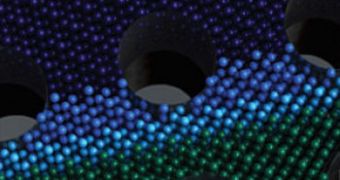In a finding that could lead to the development of highly-efficient thermoelectric devices, researchers in the United States managed to produce a new type of nanomesh material.
The new meshes are made out of silicon, which is one of the most abundant chemicals on our planet, and they could make existing thermoelectric devices a lot more efficient.
The goal of such machines is to harness heat-energy, such as the one that light bulbs, computers, car radio and humans let escape while they function. In other words, the heat your computer generates may be used for producing electricity.
But, in order to make this type of production count, you need a device that can be very efficient at conversion, and current designs are lacking at best. This is where the new material comes in.
It replaces some of the chemicals used to make the most efficient thermoelectric machines today. Generally, these substances are very harmful to the environment, and also expensive.
The new material was developed at the California Institute of Technology (Caltech), in Pasadena, and it's basically looks like a very thin film with tiny holes punched through it.
“In terms of controlling thermal conductivity, these are pretty sophisticated devices,” explains Caltech professor James Heath, who was the leader of the research effort.
Details of the nanomesh will appear in the upcoming October issue of the esteemed scientific journal Nature Nanotechnology.
The paper is called “Reduction of thermal conductivity in phononic nanomesh structures,” adds Heath, who is also the Elizabeth W. Gilloon Professor at Caltech, and a professor of chemistry.
He explains that the design the mesh has makes it capable of slowing down heat passing through it extensively. In other words, the silicon's thermal conductivity is lowered to the chemical's theoretical limit.
“[...] Caltech team built a nanomesh material from a 22-nanometer-thick sheet of silicon. The silicon sheet is converted into a mesh – similar to a tiny window screen – with a highly regular array of 11- or 16-nanometer-wide holes that are spaced just 34 nanometers apart,” the team adds in a press release.
“Although the electrical conductivity of the nanomesh remained comparable to regular, bulk silicon, its thermal conductivity was reduced to near the theoretical lower limit for silicon,” the team adds.
According to the researchers, there is still room for improvement, as in slow down heat passing through the nanomesh even more. It remains to be seen where this line of research will lead.

 14 DAY TRIAL //
14 DAY TRIAL //